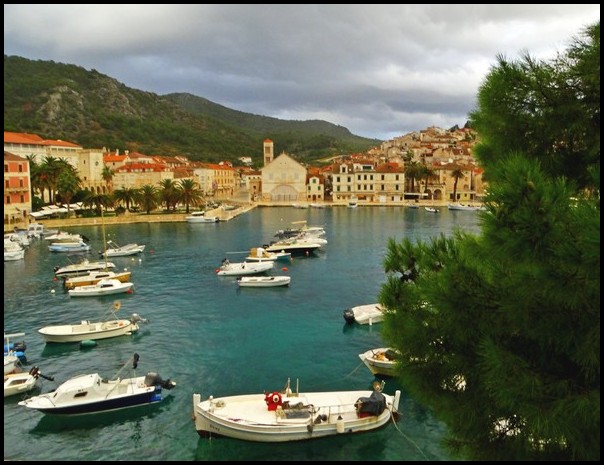
quaint historic Hvar town
All About Wonderful Hvar Island– Croatia
Hvar is a long narrow, pine forest covered island situated just off the coast of Split, Croatia. Split is located about halfway down Croatia’s long Adriatic Coast.
Hvar is probably Croatia’s most famous island and biggest tourist draw, particularly for celebrities, the rich & famous and other jet-setting world travelers, who head to Hvar for lively, hedonistic summertime island vacations.
The center for tourism these days is the quaint little historic harbor town also called Hvar, which is set around a small bay with a wide stone waterfront promenade. The town is still entirely intact with its original stone buildings, churches, plazas, a hilltop stone fortress and cobblestone streets & stairs.
Around Hvar island there are a handful of other, even smaller, historic harbor towns that also attract visitors, as well as dozens of small pebble beaches dotted around the island and Hvar’s famous lavender fields.
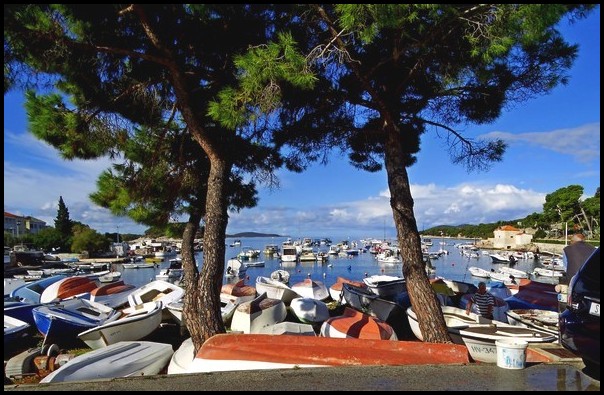 Hvar’s main points of fame
Hvar’s main points of fame
Hvar’s single most point of fame, as mentioned above, is its lively summertime party scene, frequented by famous celebrities and wealthy jet-setting world travelers. Hvar is also famous among sailors, who breeze through in private sailing boats and sleek power yachts. Hvar is consistently listed by Conde Naste Traveler as one of the world’s Top 10 travel destinations.
Secondarily, Hvar is famous for its stunning & quaint historic stone towns, including Hvar and Stari Grad; the island’s extensive lavender fields, which come into bloom in June and July; a unique historic Greek agricultural field system dating to the 300s BC and a UNESCO World Heritage Site; boat trips to neighboring islands and caves; and the Hvar Summer Festival.
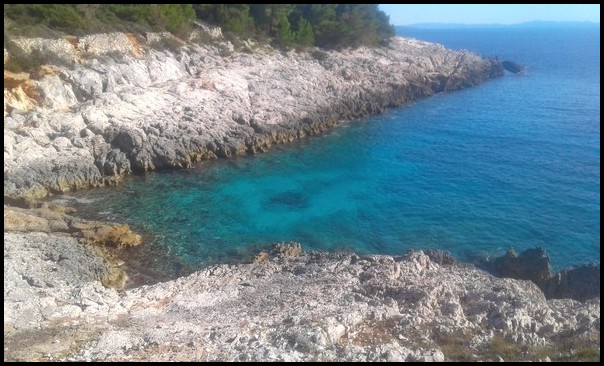 Geography of Hvar
Geography of Hvar
Hvar island is 42 miles / 68 km long but only 2.5 miles / 4 km wide for most of its length. The island runs east-west, with most of the population living in small towns and villages towards the western end, where the island is also considerably wider at about 5 miles / 8 km across.
From a distance, Hvar looks like a soft pine-forest clad, long low mound rising up from the sea. It’s only when you arrive on the island that you realize it’s actually quite rugged and mountainous, with dramatic rocky coastlines, plunging cliffs, hundreds of small stoney bays, huge rock promontories, high mountains & hills, dense pine forests and very winding hilly roads.
The island is composed of iron-hard limestone and dolomite mountains, with a long mountain spine running the length of the island. Hvar is blessed with fresh water springs, a mild climate and fertile soil (after farmers remove never-ending layers of stones).
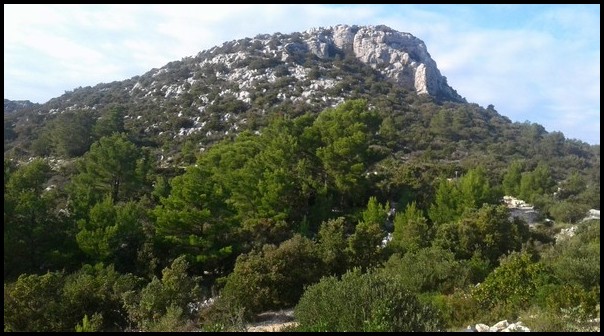 Hvar is primarily agricultural, full of hard-earned farms full of olive groves, grape orchards, fruit & vegetable gardens and lavender fields. Huge piles of rocks densely dotting the hills and a series of low stone walls hint at the tremendous work endured to wrest the precious soil plots from the incredibly rocky land.
Hvar is primarily agricultural, full of hard-earned farms full of olive groves, grape orchards, fruit & vegetable gardens and lavender fields. Huge piles of rocks densely dotting the hills and a series of low stone walls hint at the tremendous work endured to wrest the precious soil plots from the incredibly rocky land.
The Adriatic Sea at Hvar is an almost unbelievably clear pale green color. On most days you can see clearly to the bottom and can easily make out individual fish, sea urchins, stones, corals (and any debris too).
Hvar’s innumerable picturesque little bays and coves have pebble beaches. Some are surrounded by soaring white cliffs, while others are flat, surrounded by beautiful pine forests.
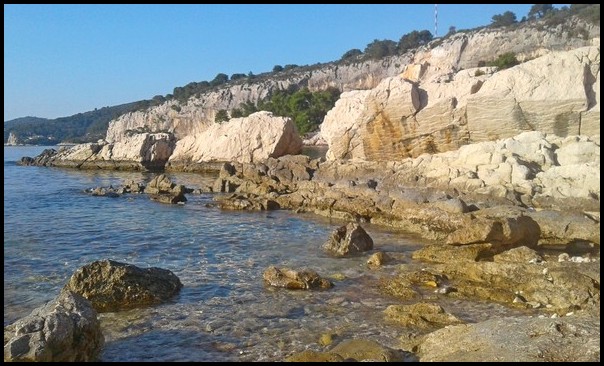 Why Hvar is so Amazingly Wonderful
Why Hvar is so Amazingly Wonderful
Given Hvar’s fame as a huge summer party destination and its long-standing multiple-century-old tourist industry (see details below), it would be natural to conclude that Hvar must be horribly over-developed and full of tourist traps, tacky souvenir shops and pushy touts.
Quite fortunately, and perhaps rather amazingly, that has not happened to Hvar. In fact, quite the opposite is true. And perhaps that’s exactly its continuing great appeal.
To this day, Hvar island pretty much consists of just undeveloped nature, quaint historic towns, and small privately-owned farms of olives, grapes, vegetables or lavender.
Take Hvar town for example. As I mentioned already, the beautiful historic town is still intact with all its original stone buildings and cobblestone streets. Thankfully, it has not been overrun by new construction, junky souvenir shops or any chain restaurants/bars.
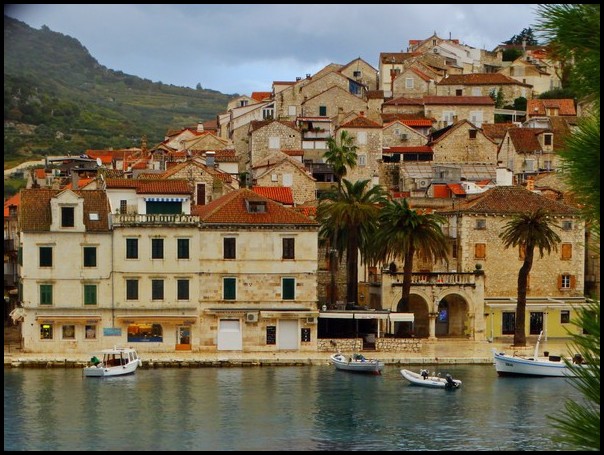 Of course the town has expanded outward somewhat onto nearby hills, now filled with modern residential areas. But it hasn’t expanded so very much, nor has the area been filled with high condo buildings, massive hotels or sky scrapers.
Of course the town has expanded outward somewhat onto nearby hills, now filled with modern residential areas. But it hasn’t expanded so very much, nor has the area been filled with high condo buildings, massive hotels or sky scrapers.
Although the new residences are not nearly as attractive as the original stone town buildings, at least they mimic the originals with white facades, red tiled roofs and only 2-4-story constructions. They blend in, more or less.
When you take into account that Hvar is the island’s biggest, most developed town, it starts to become clear that the island has not fallen to modern development.
Perhaps more amazingly, the rocky coastlines and small pebble bays near Hvar town have all been left in a natural state! There are absolutely no giant hotels, no gaudy restaurants or over-sized bars, no shops or entertainment facilities.
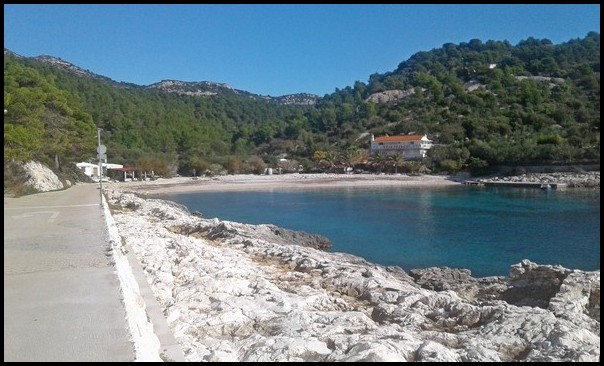 Walk out of Hvar town, and you’ll first head along a simple road lined by lovely coastal houses, then onto a primarily pedestrian walkway through pine forest to the first beach, called Mustaco. From there, only one simple walking trail leads right along the coast through pine forest and past several all-natural pebble beach coves to the tiny settlement of Milna. There are a couple isolated coastal restaurants and bars, all constructed in a low-key rustic style. And that’s it. Just nature.
Walk out of Hvar town, and you’ll first head along a simple road lined by lovely coastal houses, then onto a primarily pedestrian walkway through pine forest to the first beach, called Mustaco. From there, only one simple walking trail leads right along the coast through pine forest and past several all-natural pebble beach coves to the tiny settlement of Milna. There are a couple isolated coastal restaurants and bars, all constructed in a low-key rustic style. And that’s it. Just nature.
Also rather amazingly, Hvar island has extremely limited public bus service. A few buses per day run between the three main western island towns of Hvar, Stari Grad and Jesla. One bus per week runs the entire length of the island. And that’s about it.
Visitors hoping to explore the island further afield need to bring a car over on the car ferry from Split or else rent a car or scooter on the island.
Outside of a few small towns, Hvar Island is pretty much still in a natural state, completely undeveloped for tourism. There are several tiny villages, mostly in small bays along the coasts, many pebble beaches set in beautiful clear coves, and lots of narrow winding roads. There are many interior farms for olives, grapes and vegetables. And there are several places to camp.
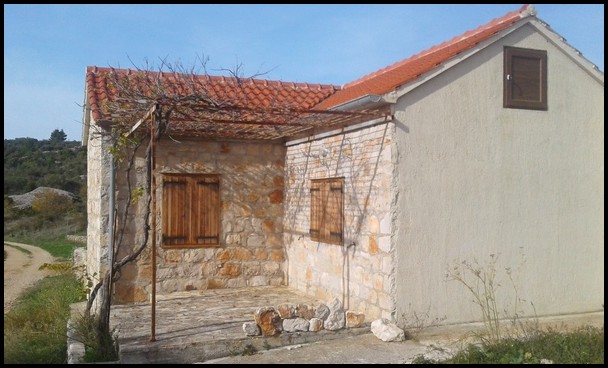 Brief history of ancient tourism to Hvar
Brief history of ancient tourism to Hvar
Rather amazingly, tourism to Hvar dates all the way back to Roman Empire times when rich Romans built stone country villas and estates all over the island. It’s estimated there were about 100 Roman villas on Hvar. Today, many of their stone remains can still be seen scattered around the island.
That means travelers have been visiting Hvar Island for more than 1700 years! Other stories report even earlier visits by prominent Greeks and other Europeans in the late centuries of the BCs.
In fact, the island’s oldest town, Stari Grad, was founded by Ionian Greeks in the 300s BC! It’s generally considered Croatia’s oldest town.
Much later, during the 15th -19th Centuries various European visitors frequented Hvar, most of them rich aristocrats, royalty, diplomats, titled men, scientists and other wealthy travelers. The main focus of travel to Hvar varied over the centuries, including scientific investigations (animals, plants, etc), stops during pilgrimages to Jaffa (now Tel Aviv), health vacations (due to Hvar’s ideal climate), rustic summer getaways to quaint inland country homes, and seaside vacationing.
The first traveler lodges and inns were set up in Hvar town in the mid 1500s and the first hotels were built in the late 1800s.
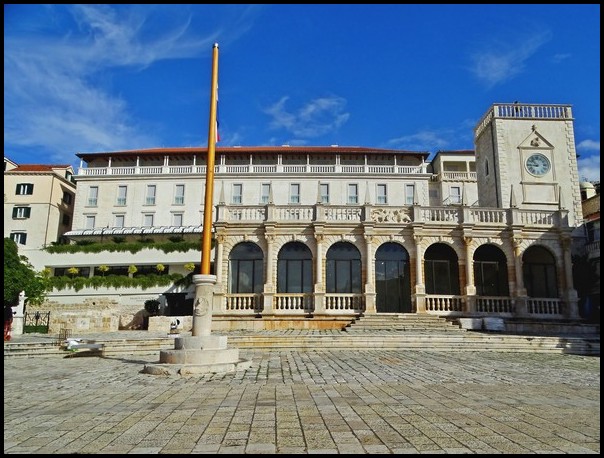
Palace Elisabeth Hotel
Brief history of modern tourism to Hvar
The foundations of modern day tourism in Hvar began with the formation of Hvar Curative Health Society in the late 1800s. Their purpose was to welcome and promote tourism to Hvar. They created brochures, postcards and other promotional material, which they distributed heavily in Europe, particularly Austria, Germany and Croatia.
They also commissioned several hotels to be built in Hvar town, most notably Hvar’s first luxury hotel, for which they secured patronage by Austria’s Empress Elisabeth. The grand 4-story neo-Rennaisance style hotel was designed by Viennese architect Bertrand Schwarz and built by a Hvar contractor. It was ideally situated at the base of Hvar’s gorgeous little stone harbor & waterfront promenade.
The luxurious beige-stone hotel was officially opened in 1903. It was quite a big deal at the time, bringing many important modern conveniences to Hvar for the first time, including indoor plumbing & toilets. 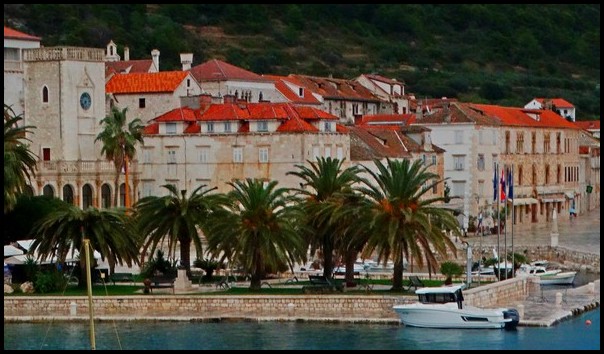
In dedication to their beloved patroness, the luxury hotel was named Empress Elisabeth Curative Health Hotel. That hotel still exists in Hvar today, though it’s changed owners and names over the centuries. It was recently fully renovated and re-opened in 2019 as Palace Elisabeth Hotel.
Not surprisingly, given the hotel’s patronage and Hvar’s long centuries of attracting upper class tourists, in the early 1900s Hvar town quickly began hosting royalty, dignitaries, aristocrats and jet-setting world travelers.
The Curative Health Society and other Hvar establishments continued to help improve its tourist appeal with town beautification projects such as creating a stunning wide stone pedestrian walk along the curving coast in both directions from town, putting in landscaped parks, cleaning up town streets, creating the Hvar Society of Cultural and Social Entertainment and building the stone ‘loggia’ in front of the big hotel, a place for public gathering and socializing.
In the 1920s the town built a huge ‘bathing resort’ in the bay just around the corner from Hvar town. It’s still there today and consists of several levels of long stone/cement platforms along the water’s edge. Today it’s called the ‘beach club’, and has a bar/cafe and sunchairs & umbrellas for rent. It’s a very lively, bustling place in summer.
Hvar has continued attracting the rich & famous ever since. In the 1920s & 30s many artists, composers, poets and actors flocked to Hvar. In the 1960s & 70s it was filled with Hollywood film stars, other famous celebrities and jet-setting world travelers.
In the early 1990s Croatia broke away from Communist Yugoslavia, which dissolved the Republic of Yugoslavia but led to bloody wars with the neighboring countries of Serbia, Bosnia and Montenegro and the Yugoslavian military. Not surprisingly, this put a damper on tourism to Croatia and Hvar through the 1990s. The tourist ‘depression’ lasted until 2005.
Fortunately for Croatia and Hvar, from 2005 onwards, tourism has been booming again.
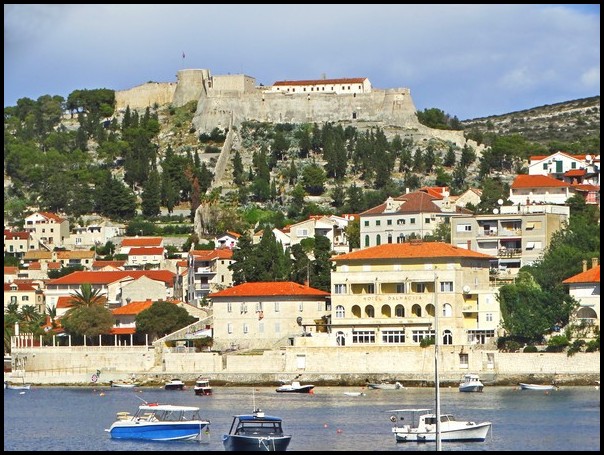 How to get to Hvar
How to get to Hvar
Getting to/from Hvar is easy and inexpensive. Daily passenger ferries run between Split and Hvar town. They take one hour and cost just 40 Kuna / about $8 US.
Larger vehicle ferries also run daily between Split and the historic island town of Stari Grad. From there, 30-minute buses run up over the mountains to Hvar town. These ferries take 2.5 hours one way and cost 39 kuna for individual passengers.
Where to stay in Hvar
Hvar town and the island have many different accommodation options, catering to all budgets. Hvar town, Stari Grad and Jelsa all have several 3-5 star luxury hotels. All the towns are also jam-packed with privately-rented rooms and apartments. Hvar town also has a few hostels for backpackers, while many campgrounds are located around the island. Some small villages also have rental rooms and apartments.
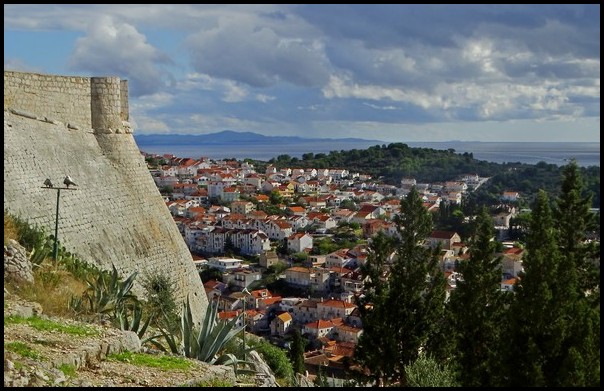 Summary
Summary
Hvar Island is one of Croatia’s most famous and popular tourist destinations. It’s particularly famous for its lively summer party scene and its rich & famous guests. Tourism on Hvar goes back at least 1700 years and has attracted wealthy travelers since that time.
Despite all that, the island and all its quaint historic harbor towns and villages have avoided over-development and tourist exploitation. The old stone towns are quite intact, the island has been left in a completely natural state.
The main draws are its gorgeous historic towns; its beautiful nature with clear sea water and small pebble beaches; its heady high-season party scene; lavendar fields and boating & sailing opportunities.
I liked Hvar so much that I returned to enjoy it beauty and serenity for an extra month! I’ll be writing about my own adventures on Hvar next week. Stay tuned!
You might also like:
15 Interesting Facts about Croatia
========================================











 Hi! I'm Lash, an American nomadic world traveler who's been traveling solo since 1998. I’m passionate about traveling the world nomadically and then sharing it all with you. I hope to inspire you to travel the world, to entertain you with tales from the road, and to help you reach your travel dreams. Welcome!
Hi! I'm Lash, an American nomadic world traveler who's been traveling solo since 1998. I’m passionate about traveling the world nomadically and then sharing it all with you. I hope to inspire you to travel the world, to entertain you with tales from the road, and to help you reach your travel dreams. Welcome! 




2 pings
My Adventures at Beautiful Hvar Island – Croatia - LashWorldTour
2020/11/30 at 1:20 am (UTC 8) Link to this comment
[…] « All About Wonderful Hvar Island– Croatia […]
Introduction to Bosnia
2020/12/22 at 10:03 pm (UTC 8) Link to this comment
[…] All About Amazing Hvar Island […]